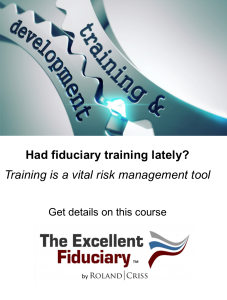Tip for February 2018

The esoteric nature of fiduciary laws and regulations provides investment service providers with a distinct advantage when selling their services to corporate or nonprofit fiduciary committees.
Of the most cerebral CEOs and executive committee members, only a small percentage of that elite class (specifically, those who have had training or education relating to pension laws like ERISA or foundation statutes like UPMIFA) are able to fully comprehend their advisors’ jargon and the legal implications of the compensation their advisors are paid.
Investment service providers leverage this position to make an (easy) argument to foundation executives and pension plan committees of why they should “leave it to the pros.”
With the combination of complicated laws, technical terminology, and the complex analyses of various investment plans on behalf of their workforce and donor groups, executives and investment committees often willingly give up control of these decisions to a team of “trusted” investment partners, who can include:
- Investment advisors, who pick a plan’s mutual funds;
- Money managers, who actually select the specific securities that go into mutual funds;
- Recordkeeping organizations; and
- Custodians (also called directed trustees).
The complicated nature of vendors’ service offerings and pricing models, as well as the disproportionate emphasis they place on projected returns, dilutes the executive team’s ability to examine the traits that really count:
- Is an advisor’s pricing structure prone to generate excessive fees for its services, especially in regards to retirement plans?
- Do they harbor conflicts of interest (and thus more pricing complexity) with other vendors in their supply chain?
- Do they define fiduciary duty based on their own invented terms?
If the answer is “yes” to any of the above questions, the corporate or nonprofit executive team is susceptible to potential fee gouging, or worse, inadvertent neglect of its fiduciary duty.
Tip:
Penetrating the veil of complexity is essential for investment committees, human resources directors, and C-level executives.
A periodic comprehensive risk assessment is the solution. Contact us for guidance on what an assessment should cover.




